Category: Archives
Thinking About A.I. With Stanisław Lem
Rivka Galchen at The New Yorker:
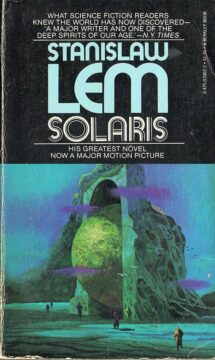 In “Summa Technologiae,” Lem emphasizes how humanity, in thinking about the future, has often thought through the wrong questions. We can transmute other metals into gold now, but it was a misunderstanding that made us think we would still want to, he says. We can fly, but not by flapping our arms, since “even if we ourselves choose our end point, our way of getting there is chosen by Nature.” When Lem writes in “Summa” about artificial intelligence—or “intelligence amplifiers,” as he terms it—he says it’s likely possible that one day there will be an artificial intelligence ten thousand times smarter than us, but it won’t come from more advanced mathematics or algorithms. Instead, it comes from machines that can learn in a way similar to how we do—which is what is happening. With the Electronic Bard, Lem derides the worry that our own human creativity will be dwarfed. That, like the questions of the alchemists, he suggests, is the wrong concern. But what is the right one?
In “Summa Technologiae,” Lem emphasizes how humanity, in thinking about the future, has often thought through the wrong questions. We can transmute other metals into gold now, but it was a misunderstanding that made us think we would still want to, he says. We can fly, but not by flapping our arms, since “even if we ourselves choose our end point, our way of getting there is chosen by Nature.” When Lem writes in “Summa” about artificial intelligence—or “intelligence amplifiers,” as he terms it—he says it’s likely possible that one day there will be an artificial intelligence ten thousand times smarter than us, but it won’t come from more advanced mathematics or algorithms. Instead, it comes from machines that can learn in a way similar to how we do—which is what is happening. With the Electronic Bard, Lem derides the worry that our own human creativity will be dwarfed. That, like the questions of the alchemists, he suggests, is the wrong concern. But what is the right one?
more here.
Wednesday, February 28, 2024
‘Indescribably filthy’: historian Emily Cockayne on the letters that landed her a film deal
Donna Ferguson in The Guardian:
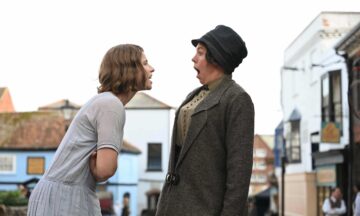 When the social historian Emily Cockayne first came across an old newspaper article about some “indescribably filthy” letters that were sent to residents of Littlehampton in the 1920s, she knew immediately that she wanted to write about it.
When the social historian Emily Cockayne first came across an old newspaper article about some “indescribably filthy” letters that were sent to residents of Littlehampton in the 1920s, she knew immediately that she wanted to write about it.
But she never dreamed that recounting the extraordinary real life events she had uncovered in a scholarly book about the history of neighbours would one day net her a film deal for a movie starring Olivia Colman, Timothy Spall and Jessie Buckley.
Wicked Little Letters, a comic thriller about the Littlehampton “poison pen” letters and the libel trials that ensued, will be in cinemas from Friday. It is based on what Cockayne describes as “the weird stuff that develops” in “a neighbourhood that’s gone awry” – a story that she first pieced together writing her 2012 book, Cheek by Jowl: A History of Neighbours. “I was researching neighbours and trying to put together various ways neighbours could be in conflict,” said Cockayne, who is an associate professor in early modern history at the University of East Anglia and worked as an expert consultant on the film.
More here.
A New Agenda for Low-Dimensional Topology
Kevin Hartnett in Quanta:
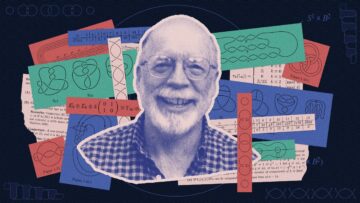 On a recent October morning, Rob Kirby stood in front of a roomful of mathematicians and told them not to feel bound by the way he’d done things in the past.
On a recent October morning, Rob Kirby stood in front of a roomful of mathematicians and told them not to feel bound by the way he’d done things in the past.
For the past half-century Kirby, 85, has been a central figure in low-dimensional topology, the study of deformable shapes. In addition to important research contributions, in 1978 he published the first version of what came to be known as “Kirby’s list” — a collection of 80 open problems that helped set the research agenda for the field over the next few decades. Two decades later, in 1997, he published a second, equally influential version of the list.
The few dozen mathematicians Kirby was addressing had convened at the American Institute of Mathematics (AIM) in Pasadena to create a third version of the list.
More here.
Alon Levy: The United States has the most expensive transportation infrastructure in the world and That’s because we refuse to learn from experts, other countries, and our own history
Alon Levy interviewed at Asterisk:
 Asterisk: The overarching question in your transit policy career has been: Why is America so bad at building transit systems? Earlier this year, your team at NYU released a massive report comparing transit costs in Istanbul, Italy, Sweden and Boston, and then, of course, New York. It culminates in your fantastic case study of the Second Avenue subway line. And that’s where I wanted to start. What went wrong?
Asterisk: The overarching question in your transit policy career has been: Why is America so bad at building transit systems? Earlier this year, your team at NYU released a massive report comparing transit costs in Istanbul, Italy, Sweden and Boston, and then, of course, New York. It culminates in your fantastic case study of the Second Avenue subway line. And that’s where I wanted to start. What went wrong?
Alon Levy: Let’s go back to John Hylan. Hylan was a populist mayor between 1918 and 1925. He ran against various corporate interests, which at the time included private streetcar companies. Hylan was hostile to the private operators. This led to bustitution — using buses to undercut the streetcar companies, though even then it was clear that the buses were providing inferior service that cost more to provide.1
And he was also against the private companies that were running the subway. So the city started building something called the Independent Subway System, commonly known as IND (because the private companies were called IRT, Interborough Rapid Transit). It was built by the city with the express purpose of driving the privates out of business — so the lines were kind of duplicative of the older lines. Only in two places did they truly expand into new places that were not served before. One is the G train, the Crosstown Line between Long Island City and downtown Brooklyn. The other is the Queens Boulevard line.
It added value. But it was also redundant on purpose — and it culminated in the city buying out the private operators at Depression prices.
More here.
The exciting, perilous journey toward AGI
Triumph & Tragedy: The Life of Michael Jackson
Mikal Gilmore in Rolling Stone:
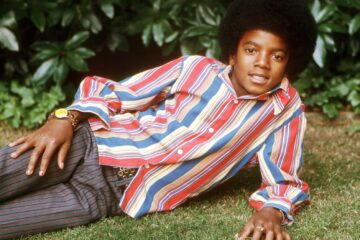 He was, in the end, precisely what he claimed and struggled to be: the biggest star in the world. If there had been any doubt, it ended on the afternoon of June 25th, 2009, when the news broke that Michael Jackson had died of apparent cardiac arrest in Los Angeles at age 50. The outpouring of first shock, then grief, was the largest, most instantaneous of its kind the world had ever known, short of the events of September 11th, 2001. Though the deaths of John F. Kennedy and Martin Luther King Jr. affected history more, and the deaths of Elvis Presley, John Lennon and Kurt Cobain signified the end of epochs, no single death has ever moved so fast around the globe, or to the forefront of all news, as swiftly as Michael Jackson’s.
He was, in the end, precisely what he claimed and struggled to be: the biggest star in the world. If there had been any doubt, it ended on the afternoon of June 25th, 2009, when the news broke that Michael Jackson had died of apparent cardiac arrest in Los Angeles at age 50. The outpouring of first shock, then grief, was the largest, most instantaneous of its kind the world had ever known, short of the events of September 11th, 2001. Though the deaths of John F. Kennedy and Martin Luther King Jr. affected history more, and the deaths of Elvis Presley, John Lennon and Kurt Cobain signified the end of epochs, no single death has ever moved so fast around the globe, or to the forefront of all news, as swiftly as Michael Jackson’s.
In the days that followed, news channels, TV specials, feature magazines and front pages tried to understand what happened. Not so much the events of Jackson’s death – though there was confusion surrounding that – but rather the nature of his life and legacy. He was a man with a complicated personality, a man with a history that was both glorious and notorious. He was not a man that anybody felt nothing about. The most affecting statement I heard came from a young black man, Egberto Willies, whose self-chronicled video statement aired on CNN: “I grew up,” Willies said, and paused a beat, “on Michael Jackson. I loved … Michael Jackson. I hated … Michael Jackson. I admired … Michael Jackson. I was ashamed … of Michael Jackson. I was sorry … for Michael Jackson. I was proud … of Michael Jackson.”
More here. (Note: In honor of Black History Month, at least one post will be devoted to its 2024 theme of “African Americans and the Arts” throughout the month of February)
Michael Jackson – Billie Jean
More here. (Note: In honor of Black History Month, at least one post will be devoted to its 2024 theme of “African Americans and the Arts” throughout the month of February)
Wednesday Poem
“These poems are about revolutionaries and Lovers; and about the loss of compassion, trust and the ability to expand in love that marks the end of hopeful strategy. Whether in love or revolution. They are also about (and for) those few embattled souls who remain painfully committed to beauty and love even while facing the firing squad.
“Humbly for my heroes, heroines, and friends of early SNCC . . . And for the Mississippi Delta legend of Bob Moses. And for Winson Hudson and Fanny Lou Hamer . . . And for my friend Charles Merrill, the artist who paints skies. —Alice Walker
~~~~~~~~~~~~~~~~~~~~~~~~~~~~~~~~~
In These Dissenting Times
To acknowledge our ancestors means
we are aware that we did not make
ourselves, that the line stretches
all the way back, perhaps, to God; or
to Gods. We remember them because it
is an easy thing to forget: that we
are not the first to suffer, rebel,
fight, love and die. The grace with
which we embrace life, in spite of
the pain, the sorrows, is always
a measure of what has gone before.
by Alice Walker
from Her Blue Body Everything We Know
Harvest Books, 1991
Wifedom: Mrs Orwell’s Invisible Life
Martin Tyrrell at the Dublin Review of Books:
 Eileen O’Shaughnessy married George Orwell in 1936 and remained married to him until her unexpected and untimely death in 1945. Anna Funder’s Wifedom is primarily an analysis of that nine-year marriage, which Funder concludes as having been throughout to Eileen’s disadvantage, an ‘arms race to mutual self-destruction: she by selflessness, and he by disappearing into the greedy double life that is the artist’s, of self + work’. The Orwell that emerges from this account was variously exploitative, neglectful, hypocritical and adulterous, not to mention a tepid and unremarkable lover and, who knows, a tortured and in-denial homosexual. Separate from his life with Eileen he was an inept seducer, occasional stalker, and, on at least two occasions, thwarted rapist.
Eileen O’Shaughnessy married George Orwell in 1936 and remained married to him until her unexpected and untimely death in 1945. Anna Funder’s Wifedom is primarily an analysis of that nine-year marriage, which Funder concludes as having been throughout to Eileen’s disadvantage, an ‘arms race to mutual self-destruction: she by selflessness, and he by disappearing into the greedy double life that is the artist’s, of self + work’. The Orwell that emerges from this account was variously exploitative, neglectful, hypocritical and adulterous, not to mention a tepid and unremarkable lover and, who knows, a tortured and in-denial homosexual. Separate from his life with Eileen he was an inept seducer, occasional stalker, and, on at least two occasions, thwarted rapist.
In contrast, Eileen gave up her promising career in educational psychology to share his spartan lifestyle in a shack in Wallington. There she toiled at the mundane while he worked endlessly on writings that paid little, at least during his and her lifetime.
more here.
Yoko Ono’s Seriously Playful Art
Tracey Thorn at The New Statesman:
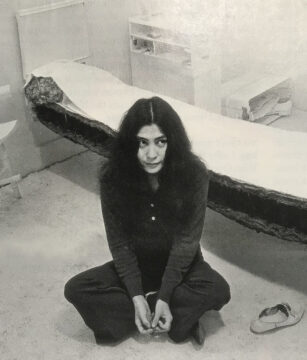 Halfway round the new “Yoko Ono: Music of the Mind” exhibition at Tate Modern (on until 1 September) I enter into a kind of record-shop listening booth that is decorated with her album covers and filled with individual sets of headphones. It’s the least crowded section of the show – Yoko’s music still perhaps not being people’s favourite thing about her – but I’m happy that her records are included here. So I put on a song I love, “Death of Samantha”, from 1973.
Halfway round the new “Yoko Ono: Music of the Mind” exhibition at Tate Modern (on until 1 September) I enter into a kind of record-shop listening booth that is decorated with her album covers and filled with individual sets of headphones. It’s the least crowded section of the show – Yoko’s music still perhaps not being people’s favourite thing about her – but I’m happy that her records are included here. So I put on a song I love, “Death of Samantha”, from 1973.
The opening lines always make me smile: “People say I’m cool/Yeah I’m a cool chick baby/Every day I thank God/That I’m such a cool chick baby”. It’s a defiant opening to a song, but also clearly very tongue-in-cheek. No one refers to themselves as a “cool chick baby” with an entirely straight face, Yoko least of all, and we’ll come back to her humour in a minute.
more here.
Yoko Ono At The Tate
Tuesday, February 27, 2024
The Redemption of Al Sharpton
Mitchell S. Jackson in Esquire:
 Can’t tell you what Martin Luther King Jr. was doing in the hours, minutes, before he delivered his “I Have a Dream” speech, but I can tell you that sixty years later, Alfred Charles Sharpton Jr. is sitting in an upholstered wooden chair in his trailer, parked on a fence line behind the Lincoln Memorial, fielding calls on his cell phone about today’s rally, at which he will deliver his own speech. Can’t tell you the logistical concerns MLK solved himself in the minutes before he gave his most famous public address, but I can tell you that Sharpton’s cell is ring ring ringing with handlers and schedulers panicked about the lineup, about having the event shut down by the National Park Service for the bureaucratic alibi that it has run past its permitted time.
Can’t tell you what Martin Luther King Jr. was doing in the hours, minutes, before he delivered his “I Have a Dream” speech, but I can tell you that sixty years later, Alfred Charles Sharpton Jr. is sitting in an upholstered wooden chair in his trailer, parked on a fence line behind the Lincoln Memorial, fielding calls on his cell phone about today’s rally, at which he will deliver his own speech. Can’t tell you the logistical concerns MLK solved himself in the minutes before he gave his most famous public address, but I can tell you that Sharpton’s cell is ring ring ringing with handlers and schedulers panicked about the lineup, about having the event shut down by the National Park Service for the bureaucratic alibi that it has run past its permitted time.
On the umpteenth such call, Sharpton, who’s about as calm as an August breeze, tells the anxious messenger to get ahold of Stephen K. Benjamin, a senior advisor to President Biden, and have him handle it.
More here.
Life Aboard a Nuclear Submarine
Adam Ciralsky in Vanity Fair:
 Under cover of darkness, I boarded a Navy vessel at a heavily guarded military base along the Eastern Seaboard. The location and time of departure, as well as the direction and distance of travel, were unknown to me. Adding to the sense of secrecy, a towering sailor in camouflage stood in the rain, examining my belongings for electronics that might leave a digital trail an adversary could intercept and exploit.
Under cover of darkness, I boarded a Navy vessel at a heavily guarded military base along the Eastern Seaboard. The location and time of departure, as well as the direction and distance of travel, were unknown to me. Adding to the sense of secrecy, a towering sailor in camouflage stood in the rain, examining my belongings for electronics that might leave a digital trail an adversary could intercept and exploit.
Buffeted by strong winds and high Atlantic seas, the support ship sailed through the night for more than 15 storm-tossed hours toward a destination somewhere off the continental shelf. Just after dawn, a sleek, inky object appeared in the distance, right above the waterline. It was the protruding bridge of what sailors call a “boomer”—a submarine armed to the gills with nuclear missiles—which is considered the most lethal, stealthy, and survivable weapon in America’s strategic arsenal.
More here.
Tools for Thinking About Censorship
Ada Palmer in Reactor:
 “Was it a government action, or did they do it themselves because of pressure?”
“Was it a government action, or did they do it themselves because of pressure?”
This is inevitably among our first questions when news breaks that any expressive work (a book, film, news story, blog post etc.) has been censored or suppressed by the company or group trusted with it (a publisher, a film studio, a newspaper, an awards organization etc.)
This is not a direct analysis of the current 2023 Chengdu Hugo Awards controversy. But since I am a scholar in the middle of writing a book about patterns in the history of how censorship operates, I want to put at the service of those thinking about the situation this zoomed-out portrait of a few important features of how censorship tends to work, drawn from my examination of examples from dozens of countries and over many centuries. The conclusions here are helpful for understanding this situation, but equally applicable to thinking about when school libraries bow to book ban pressures, how controversies impact book publishing in the USA and around the world, and historical cases: from the Inquisition, to censorious union-busting in 1950s New Zealand, to the US Comics Code Authority, to universities censoring student newspapers, etc.
More here.
The most famous equation in finance, the Black-Scholes/Merton equation
Tuesday Poem
Beast
Whenever I do not create
I feel like a beast.
A beast they say
is a being who
through horror
and impoverishment
loses its soul.
Earth
I beg of you
a beast
in the making
to reclaim
creation
as a rolling over
of the soul.
The absolute
willful,
self-assurance
that there is
no lack.
I beg of you
rise again.
Shake the concrete
off your back.
by Alice Walker
from Her Blue Body Everything We Know
Harvest Books, 1991
The Re-Discovery Of Alchemy
Travels In The Binge Of TV
Peter Campion at the LARB:
 READING DAVID THOMSON’S new book about television, Remotely: Travels in the Binge of TV, I remembered a beguiling moment in his 2016 history of the medium, Television: A Biography. At the end of that book, Thomson includes a photograph of a young man at a trade show with his eyes—the entire top of his head, in fact—covered by black virtual-reality glasses. The image exudes a dopey cheerlessness, as if his high-tech leisure-seeking has annulled the poor guy himself. Or is the feeling even worse—blunt menace, as if this man were some futuristic Cyclops? Under the photo is a short passage:
READING DAVID THOMSON’S new book about television, Remotely: Travels in the Binge of TV, I remembered a beguiling moment in his 2016 history of the medium, Television: A Biography. At the end of that book, Thomson includes a photograph of a young man at a trade show with his eyes—the entire top of his head, in fact—covered by black virtual-reality glasses. The image exudes a dopey cheerlessness, as if his high-tech leisure-seeking has annulled the poor guy himself. Or is the feeling even worse—blunt menace, as if this man were some futuristic Cyclops? Under the photo is a short passage:
It is Oculus now; it will have rivals and other names. Perhaps it is just the latest big thing, soon to be surpassed. But it may be a radical reappraisal of movie and TV so far. So big a thing, it makes us forget the past.
Meanwhile, just look at it. Isn’t it the best evidence that we are becoming screens—plastic, masked, anonymous, isolated?
more here.
Writing Shanghai’s Rooftoppers
Aube Rey Lescure at The Millions:
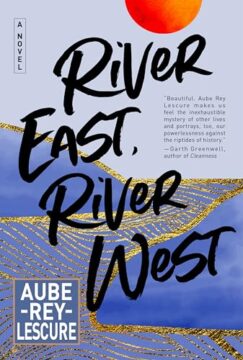 When I began writing a novel about adolescence in Shanghai, I knew rooftopping would weave into its fabric. I didn’t personally know any rooftoppers, but the mentality that drove so many young men to take up rooftopping was everywhere around me. I’d attended Chinese public schools through eighth grade and knew of boys who were deemed “problem students,” who disappeared for days and nights into cybercafe binges, who drank and fought and, once kicked out, would never be seen again. In eighth grade, a boy came to class with a knife and threatened to kill a girl—they’d been secretly dating, the girl’s parents found out and accused him of rape, and he was subsequently expelled from school and evicted by his parents. He’d been living and working in the barracks of a construction site not too far from school. I remembered his hysteria and desperation, though the knife never fell. He’d collapsed and been pulled away. But I remember thinking that this is what it meant to fall off track in this country: There was only one prescribed way forward, and once you diverged from the path, you were abandoned at the margins of a society that sped ahead and never looked back.
When I began writing a novel about adolescence in Shanghai, I knew rooftopping would weave into its fabric. I didn’t personally know any rooftoppers, but the mentality that drove so many young men to take up rooftopping was everywhere around me. I’d attended Chinese public schools through eighth grade and knew of boys who were deemed “problem students,” who disappeared for days and nights into cybercafe binges, who drank and fought and, once kicked out, would never be seen again. In eighth grade, a boy came to class with a knife and threatened to kill a girl—they’d been secretly dating, the girl’s parents found out and accused him of rape, and he was subsequently expelled from school and evicted by his parents. He’d been living and working in the barracks of a construction site not too far from school. I remembered his hysteria and desperation, though the knife never fell. He’d collapsed and been pulled away. But I remember thinking that this is what it meant to fall off track in this country: There was only one prescribed way forward, and once you diverged from the path, you were abandoned at the margins of a society that sped ahead and never looked back.
more here.
